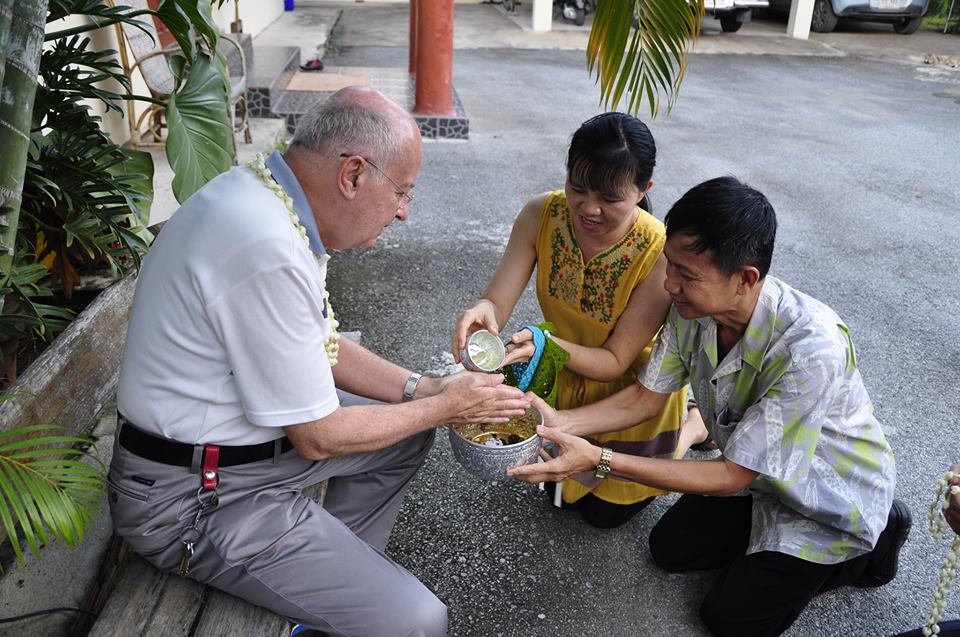|
SONGKRAN is the traditional Thai New Year. To be precise, it is the date that Central Thai culture of Ayutthaya and Bangkok celebrated the New Year until the push came to show that Siam was part of the modern, civilized world, and New Year’s Day was moved to January 1. It is the only annual, traditional-religious celebration in Thailand aligned with the sun rather than the moon. It is April 13, expanded to April 13-15.
Culture tends to flow from centers of power to areas with less power, or diminishing power. So in Chiang Mai the old customs are either swept away or they are transformed and incorporated. Culture, along with its components such as language and religion, is always evolving. It is nostalgic nonsense to think otherwise. Here in the North Songkran includes several diverse background traditions including: (1) honoring elders, (2) being blessed by them, (3) washing Buddha images, (4) building sand chedis in temple grounds, (5) taking wooden props (mai kham ton Bo) to the Bo tree in the temple, (6) making merit for deceased ancestors, and incidental events a village might organize. In Northern Thailand pouring water is still a ritual way of transferring blessings. It is part of every funeral and almost all other merit-making ceremonies. For Songkran the water includes an infusion of oils and dried flowers. Younger people honor the most senior members of their clan by taking small symbolic gifts to them, including a cloth item. They greet their elders with utmost respect, anoint the elder’s hands with the scented water which the elder transfers to his or her own head, and then returns the blessing by tying a white string around the younger person’s wrist while intoning a chanted wish for longevity, health, wealth, success and prosperity. Among persons of nearer the same age and status one could dare to pour a bit of water directly onto the other’s head or shoulder – which was bare in the old days, the custom of the times being “topless” or nearly so. The custom was reminiscent of giving the other person a bath, one of the most sacrosanct things a person could do. Much of that remains in village culture. For most of living memory, however, a second layer of tradition has been incorporated that comes from a different strand of tradition, the magical or sympathetic use of water to bring on rain. I am told that in times of extreme drought one of the rituals involved drenching a cat, whose cries would arouse a response from nature. More humanely, the ritual involved parading particular Buddha images (only certain ones) through the streets or pathways to allow people to anoint them with water, again to encourage rain to return. As it happened, once the parade has passed the people can happily anoint one another. If the crowd is younger or feeling more carefree the mutual anointing can become boisterous and resemble a water fight. Now there is a third layer of tradition taking over in which most of the religious connotations are neglected or obscure. Songkran is now divided into two distinct festivals. The traditional one still involves trips to the temple and visits to elders. The other festival is all about playing with water. An entire “industry” has built up around this water festival. The Tourism Authority of Thailand optimistically expects half a million tourists to arrive for a water fight. Here in Chiang Mai the battle will be around the city moat where streets will be clogged or entirely blocked fromnoon to dusk. Since venting aggression is an aspect of this, fueled with alcohol, the water throwing can be rowdy. As inhibitions are shed so can extraneous clothing. Tourists from overseas may not have any idea, nor care, about local mores and behavioral limits. It can be photogenic. The Culture Ministry has already produced a set of TV spots to express their indignation. Meanwhile, thousands of people will be heading out of the city toward cleaner rivers to the South-West. The lucky ones will get to Ob Khan or Mae Wang in time to rent a little bamboo platform with a leaf roof and eat and drink their way through the day while children splash in the water. Those who get there later will find a shady spot to spread a mat on the ground and send the kids to join the crowd in the water.
0 Comments
Leave a Reply. |
AuthorRev. Dr. Kenneth Dobson posts his weekly reflections on this blog. Archives
March 2024
Categories |
| Ken Dobson's Queer Ruminations from Thailand |
|

 RSS Feed
RSS Feed
